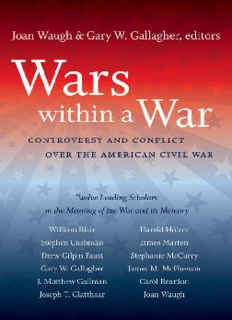
Wars within a War: Controversy and Conflict over the American Civil War (Civil War America) PDF
Preview Wars within a War: Controversy and Conflict over the American Civil War (Civil War America)
Wars within a War Civil War America (cid:3) (cid:2) (cid:2) (cid:3) Gary W. Gallagher,EDITOR WARS WITHIN A WAR Controversy and Confl ict over the (cid:4) (cid:5) AMERICAN CIVIL WAR EDITED BY Joan Waugh & Gary W. Gallagher THE UNIVERSITY OF NORTH CAROLINA PRESS Chapel Hill © 2009 The University of North Carolina Press All rights reserved Manufactured in the United States of America Designed by Rebecca Evans Set in MT Walbaum and MT Latin by Tseng Information Systems, Inc. The paper in this book meets the guidelines for permanence and durability of the Committee on Production Guidelines for Book Longevity of the Council on Library Resources. The University of North Carolina Press has been a member of the Green Press Initiative since 2003. Library of Congress Cataloging-in-Publication Data Wars within a war : controversy and conflict over the American Civil War / edited by Joan Waugh and Gary W. Gallagher. p. cm. — (Civil War America) Includes bibliographical references and index. ISBN 978-0-8078-3275-2 (cloth : alk. paper) 1.United States—History—Civil War, 1861–1865—Social aspects. 2.United States— History—Civil War, 1861–1865—Influence. 3.Social conflict—United States—History— 19th century. 4.Social conflict—Southern States—History—19th century. 5.United States—Social conditions—To 1865. 6.United States—Social conditions—1865– 1918. 7.Confederate States of America—Social conditions. 8.Southern States— Social conditions—19th century. 9.War and society—United States—History—19th century. 10.War and society—Southern States—History—19th century. I.Waugh, Joan. II.Gallagher, Gary W. E468.9.W29 2009 973.7'1—dc22 2008050487 cloth 13 12 11 10 09 5 4 3 2 1 To the memory of MARY L. ARBOIT (1918–2007) and PHILIP JAMES CALLAHAN (1949–2007) This page intentionally left blank (cid:4) CONTENTS (cid:5) Introduction JOAN WAUGH AND GARY W. GALLAGHER ix Women Numerous and Armed Gender and the Politics of Subsistence in the Civil War South STEPHANIE McCURRY 1 Friend or Foe Treason and the Second Confiscation Act WILLIAM BLAIR 27 My Enemies Are Crushed McClellan and Lincoln JAMES M. McPHERSON 52 Profile in Leadership Generalship and Resistance in Robert E. Lee’s First Month in Command of the Army of Northern Virginia JOSEPH T. GLATTHAAR 68 In Your Hands That Musket Means Liberty African American Soldiers and the Battle of Olustee J. MATTHEW GALLMAN 87 With Malice toward Both Abraham Lincoln and Jefferson Davis in Caricature HAROLD HOLZER 109 Walt Whitman’s Real Wars STEPHEN CUSHMAN 137 Hollywood Has It Both Ways The Rise, Fall, and Reappearance of the Lost Cause in American Film GARY W. GALLAGHER 157 Battle over the Bodies Burying and Reburying the Civil War Dead, 1865–1871 DREW GILPIN FAUST 184 Not a Veteran in the Poorhouse Civil War Pensions and Soldiers’ Homes JAMES MARTEN 202 William T. Sherman in Postwar Georgia’s Collective Memory, 1864–1914 CAROL REARDON 223 The Nation’s Greatest Hero Should Rest in the Nation’s Greatest City JOAN WAUGH 249 Contributors 279 Index 281 (cid:4) INTRODUCTION (cid:5) The Civil War saw the United States and the Confederacy create huge armies that waged some of the bloodiest and most famous battles in Ameri- can history. The governments headed by Abraham Lincoln and Jefferson Davis sought to make the most of their respective human and material resources and strove to achieve national unity. Yet on February 28, 1863, Harper’s Weekly offered its readers a vivid portrayal of northern political dissent. The cartoon depicts a beleaguered yet defiant Columbia, her shield emblazoned with “UNION,” determined to slay three copperhead snakes threatening the U.S. war effort. Three months later, a cartoon in Frank Leslie’s Illustrated Newspaper showed southern women concerned with shortages of bread and other food rioting in Richmond’s streets. Armed with clubs and pistols, the women strike belligerent poses in front of a store’s smashed windows. Such acknowledgments of political and social conflict would not have surprised anyone at the time because both the United States and the Confederacy experienced internal dissent through- out most of the war. Union victory ensured reunion and emancipation, but heated disagreements over the war’s meaning and memory remained bit- ter in the immediate aftermath of the war and have continued in various forms to the present day. Civil War dissent sometimes has been obscured amid popular concep- tions of the conflict as a tragic but ultimately triumphant testing of the na- tion. Celebratory views accurately capture the degrees to which the people of both sides sacrificed in the course of a struggle that exacted a terrible human and material toll. Bruce Catton’s “Centennial History of the Civil War” and Shelby Foote’s The Civil War: A Narrative, two beautifully writ- ten and widely read trilogies published between 1958 and 1974, exemplify this tradition, as does Ken Burn’s immensely influential PBS documentary, titled The Civil War and first aired in 1990. Yet any account of the war
